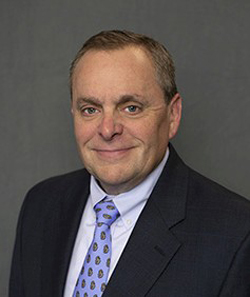March 2023, Vol. 250, No. 3
Features
INGAA Chairman Amato Sees Permitting, Workforce Development Among Priorities

By Michael Reed, P&GJ Editor-in-Chief
(P&GJ) — New INGAA Foundation Chair Paul Amato doesn’t exactly come from the hotbed of the natural gas industry, but in a manner of speaking, he became part of it as soon as possible. The native New Englander became a pipeline inspector shortly after college.
Since then his multidecade career has encompassed years at Algonquin Gas and most recently at Iroquois Pipeline Operating Company, where he is vice president, Engineering, Operations & EH&S. This has resulted in the kind of experience that makes him ideal to lead INGAA initiatives during his term.
During this interview with P&GJ, Amato discusses, among other issues, his first impressions of INGAA, training and retaining younger talent, and keeping an eye on methane reduction and other permitting issues.
P&GJ: Where are you from, and how did you decide on a career in the oil and gas industry?
Amato: I’m from West Hartford, Connecticut, not the hub of the natural gas industry by any means. While taking some time off from college to bartend I met my now wife, and we got engaged in a few months. Needless to say, my future mother-in-law was not going to have an unemployed family member when I graduated so she “encouraged” me to take the civil servant exam.
She knew of an opening for an engineer at the CT Public Utility Commission. After five years as a pipeline inspector, I moved to Algonquin Gas as a field engineer and learned an incredible amount from the technicians and other engineers / managers. Several years later, I joined Iroquois to lead their engineering group and in the blink of an eye, 36 years in the industry have passed.
P&GJ: What led to your involvement in the INGAA Foundation?
Amato: I was previously involved with the Interstate Natural Gas Association of America on the Pipeline Safety committee. Around 2008 a colleague brought me to a Foundation meeting to get more engaged with the full value chain in the industry. The value of the Foundation and opportunities membership presents became immediately apparent, and I have tried to become more engaged over time including with the Foundation Executive Committee starting in 2016.
P&GJ: How has your participation in INGAA Foundation contribute toward your career success?
Amato: Involvement with the Foundation allowed me to work with a broad spectrum of people, companies and ideas from across the industry. It also provided opportunities to get engaged in areas of the industry I don’t encounter in my day-to-day, and to develop leaderships skills.
P&GJ: What do you view as the most important items on the current INGAA Foundation agenda? Are there new programs?
Amato: I’d like to make sure the membership is getting value from the Foundation. I’m very passionate about our industry and its ability to be strategic. We need to continue educating stakeholders on how we are an integral part of a safe, clean energy future. I think it is also important to focus on the health and safety of the industry and to engage smart, driven young professionals to ensure the longevity of our industry.
We have several new programs, including a partnership with Young Pipeline Professionals (we have recently added the YPP Chair to our Executive Committee), as well as a multi-year mental health awareness program started under my predecessor, Marty Jorgenson.
P&GJ: How does the Foundation identify and deliver its annual slate of programs?
Amato: The Foundation has a well refined process to identify ideas and transform them into value added research that improved the full value chain of the industry. We solicit ideas from members based on the Foundation’s strategic goals. These ideas are then vetted through standing committees, and once refined, are presented to the full membership for ranking and subsequent approval.
P&GJ: When you talk to members, what do they express as their greatest concerns?
Amato: Permitting certainty, for both new and existing projects, the health of our employees, and the ability to attract and retain new, young talent. Through our slate of projects, we work with regulatory bodies and federal agencies to educate them in the importance of a permitting process that aligns with our nation’s long-term needs for energy reliability, affordability and climate security.
Additionally, we have several initiatives looking to ensure the long-term comprehensive health of our employees and to attract young talent.
P&GJ: Is there any new or pending legislation concerning regulations and permitting that are of significant concern?
Amato: This year we will be watching the methane rule supplemental, NOx Federal Implementation Plan and Inflation Reduction Act’s implementation of the methane emissions reduction program.
We will also be keeping a close eye on permitting reform. Already some of the proposals introduced last year have been reintroduced, and we expect to see continued momentum that hopefully results in bold, legislation that will expedite permitting timelines and judicial reviews for badly needed energy infrastructure projects.
P&GJ: What are the Foundation and the industry as a whole doing to attract younger people to midstream?
Amato: Building upon existing partnerships with organizations such as the Young Pipeline Professionals and engaging them more in committee and leadership roles. The Foundation has also been educating its members on the differences with a younger workforce and helping bridge the gap so that more experienced members, like myself, understand different ways to encourage and recruit young people to a great industry that provides safe, low-cost reliable energy to the nation.
P&GJ: How have you seen the relationship between service companies and operators change in recent years?
Amato: There is more of a partnership and a greater understanding between service companies and operators than there was when I got started in this industry. The work the Foundation committees do is a great example of competitors, operators and service providers working with the same goal: to continue to provide safe, reliable, cost-effective energy to assist in the transition to a low-carbon future.
P&GJ: What do you expect over the next two or three years, regarding new pipeline construction and expansions of existing lines?
Amato: I’m optimistic that lawmakers, regulators and other stakeholders will recognize how critical this industry is to the transition to a cleaner energy future and will pass meaningful and impactful permitting reform that enables that pipeline expansion.
Natural gas, and its related infrastructure, are critical to a reliable, secure and affordable clean energy future, and members of the INGAA Foundation work tirelessly to lower our carbon footprint while delivering safe, reliable low-cost energy.
P&GJ: Can you pick one thing you would most like to see accomplished during your time as chairman?
It's challenging to focus on one accomplishment with such a diverse membership. I will be working hard with Foundation staff and membership to ensure the Foundation is strategic, engages the younger generation, and provides tools to ensure we have a healthy workforce that is able to safely deliver clean, reliable, low-cost energy.






Comments